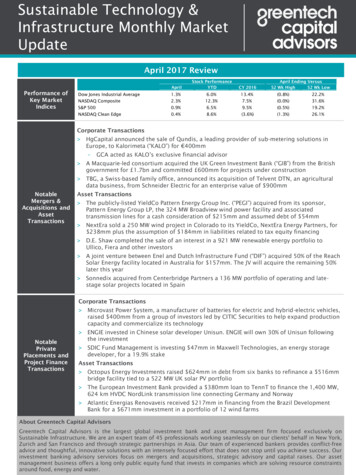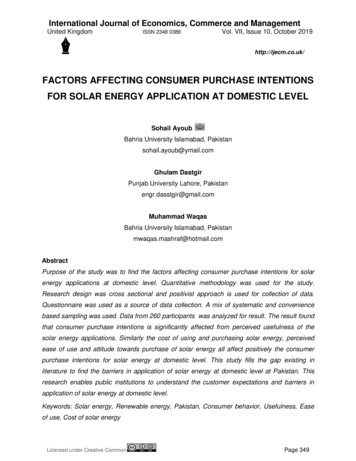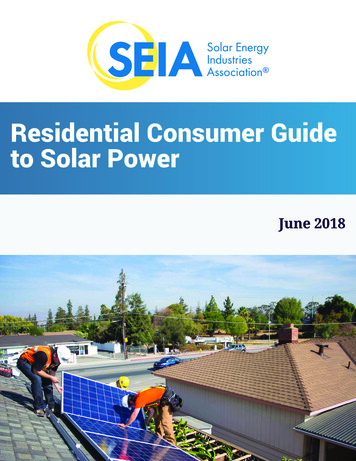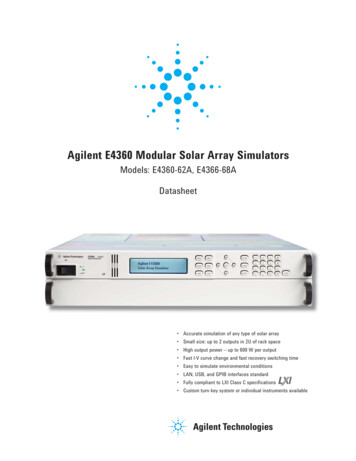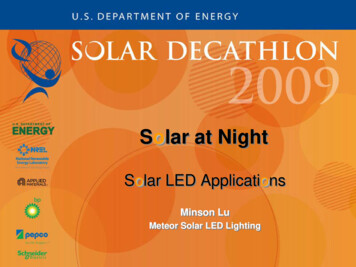
Transcription
FACTORS AFFECTING SOLAR POWERPRODUCTION EFFICIENCYNew MexicoSupercomputing ChallengeFinal ReportApril 1, 2015Team 88Miyamura High SchoolTeam Members:Ericson GordoNashat KhalafTyler StrangeowlTeacher/Sponsor:Rowena DolinoProject Mentor:Nick Bennett1
ABSTRACTSolar energy has been used for millions of years before the invention of solar panels. Manyforms of life use sunlight to survive and thrive. The forms of life that use sunlight includehumans for warmth and recently started using the energy of the sun to produce electricity that isrenewable and sustainable. Using solar panels, solar energy is converted into electrical energythat can power an entire building. The power production from three different solar panelmountings, fixed, tracking, and adjustable, will depend on several identified factors, namely:cloud cover, sun intensity, relative humidity, and heat buildup. Netlogo program is utilized inthis project to simulate the production of solar power from twenty four solar panels within anaverage of twelve daylight hours. The identified factors are controlled using sliders duringseveral trials. The results of this study have been analyzed and discussed, a conclusion has beenmade, and a recommendation for future study is included.2
TABLE OF CONTENTS1.BACKGROUND AND RESEARCH . 41.1 The Science Behind Solar Panels . 41.2 Advantages and Disadvantages of Solar Power . 41.3 Types of Solar Panel Mountings . 51.4 Factors that Affect Solar Power Production . 72.EXPERIMENTAL PROCEDURE . 72.1 Based on Research Mathematical Calculation . 72.2 Mathematical Model . 83. RESULTS . 94. DATA ANALYSIS AND DISCUSSION . 135. CONCLUSION/RECOMMENDATION . 156. FUTURE RESEARCH . 167. ACKNOWLEDGMENTS . 178. REFERENCES: . 183
1.BACKGROUND AND RESEARCH1.1 The Science Behind Solar PanelsThe sun beams more than enough energy onto the earth to meet the needs of globalenergy demand for a whole year. Solar panels produce energy less than a tenth of one percent ofthe entire global energy demand. The panels are called photovoltaic cells which are found onthings like spacecraft, rooftops, and calculators. The cells are made of semiconductor materialslike those found in computer chips. When sunlight hits the cells, it knocks the electrons loosefrom their atoms. The electrons generate electricity as they flow through the cell.A solar panel can generate power with a four-piece battery system that can be filled withunfiltered water, and the battery can recycle water to generate battery or power. If three panelsare put together, these can produce enough electrical energy to power a home with a family offour to eight people living within the structure it is powering. It also allows a vehicle to run onsolar power. In addition, a typical solar panel produces 200 watts of power or more. To power abuilding like a bank, for example, a five kilowatt-hour array, which is about 25 solar panels, isnecessary. The solar panels will absorb 1,000 watts of sunlight per square meter on the panels’surfaces. To power a high school building, a 6.25 megawatt capacity, equivalent to 24 solarpanels, is needed.1.2 Advantages and Disadvantages of Solar PowerAccording to research, the sun is now halfway in its lifetime. It is predicted to consumeits energy in another 4.5 billion years which is still way beyond a normal person’s lifetime, thusmaking the sunlight a renewable source of energy. This form of energy is reliable andsustainable; it will not run out for a very long time. Using solar panels to produce electrical4
power is ecosystem friendly; they do not emit greenhouse gases that can increase the warming ofthe Earth that have been studied to be the main cause of the drastic climate changes. In the longrun of using solar panels to produce power, people who go solar will save thousands of dollarssince the sun will keep on providing energy that is more than enough throughout their lifetime.Finally, utilizing solar power can save people from fossil fuel dependence. Fossil fuels are notonly nonrenewable but are also the main source of carbon dioxide emissions, the primarygreenhouse gas in the atmosphere.Using solar panels has its downfall such as when the weather is cloudy, it makes thetechnology unreliable. Also, the cost and placement of the solar panels can be very high mostlybecause the solar panels require a very large area that has a significant amount of sunlight to giveenergy to a lot of people.1.3 Types of Solar Panel MountingsResearch shows that there are three types of solar panel mountings. These are fixed,adjustable, and tracking. The fixed solar panel mounting system is completely stationary. This isthe simplest and cheapest type of solar panel. The solar panels are installed in such a way thatthey are always facing the equator (due south in the northern hemisphere). The angle ofinclination favors the winter sun and favors the summer sun slightly less (Peak Solar LLC,2013).FIGURE 1. Fixed Solar Panel Mount5
The adjustable solar panel mounting system includes adjusting the angle of inclination ofthe solar panel mount two or more times a year to account for the lower angle of the sun in thewinter season. This system is more expensive than the fixed mount but it increases the solarpanel power output by approximately 25%, thus making it more efficient.FIGURE 2. Adjustable Solar Panel MountThe tracking solar panel mounting system is the most expensive of the three types ofmounting. It tracks and follows the path of the sun (east to west) during the day as well as theseasonal declination movement of the sun. The tracking solar panel output increases byapproximately 25% - 30%. It cannot be denied that this type of mounting is the most efficient inproducing the greatest amount of solar power.FIGURE 3. Tracking Solar Panel Mount6
1.4 Factors that Affect Solar Power ProductionThere is no such thing as a perfect technology. Research reveals the different factors thatcan affect the efficiency of solar panel mounting systems. Some of these factors have beenstudied to either increase or decrease the power production from the three types of mountingssuch as sun intensity, cloud cover, relative humidity, and heat buildup. When the sun is in itspeak (intense), during midday, the most solar energy is collected; therefore, there is an increasein the power output. Cloudy days contribute to the decrease in sunlight collection effectivenesssince clouds reflect some of the sun’s rays and limit the amount of sun absorption by the panels.During summer days when the temperature is at its highest and heat is built up quickly, the solarpower output is reduced by 10% to 25% for the reason that too much heat increases theconductivity of semiconductor making the charges balance and reducing the magnitude of theelectric field. In addition, if humidity penetrates into the solar panel frame, this can reduce thepanel’s performance producing less amount of power and worse can permanently deteriorate theperformance of the modules.2.EXPERIMENTAL PROCEDURE2.1 Based on Research Mathematical CalculationAccording to the United States National Aeronautics and Space Administration (NASA),the approaching100% solar energy to Earth is equivalent to the solar constant of 1,353 watts persquare meter. About 34% of this energy is reflected off clouds, dust particles, and the Earth. Thebest solar energy input being recorded (during high noon and cloudless sky) is around 1,070watts per square meter. However, on the average, only around 893 watts per square meter reachEarth. Some reference sources use 893 divided by 4 which equals around 223 watts per square7
meter as the average value per hour. For every sunny day, the average power per 1 square meterof photovoltaic cell is 223 * 24 5, 300. All solar heating equipment lose so much heat whichreduces the solar panels’ efficiency to produce power. For photovoltaic panels, the efficiency ofconverting solar energy to electricity is around 7%. A square-meter panel array, composed ofabout 60-90 solar cells, will generate (5,300 * 0.07) between 370-375 watt-hours for an entiresunny day which is about 12 hours average.2.2 Mathematical ModelOur model focuses on the effect of four factors, namely: cloud cover, sun intensity,relative humidity, and heat buildup on the efficiency of each type of solar panel mounting (fixed,tracking, or adjustable) to produce the greatest amount of power within an average of 12 daylighthours a day. The number of solar panels remains constant at 24 while we manipulate, usingdifferent sliders, the value of each of the four factors being tested. To calculate for the efficiencyof each type of solar mountings, we used the formula: [power generated by the panels / the peakpower generated according to research (which is 1000 watts) * area of each solar panel (whichis 1 square meter) * total number of solar panels (which is 24) ] * 100 or ( power / 24,000 ) *100.8
FIGURE 4. Netlogo Interface Showing Solar Power Production with Cloud Cover3. RESULTSThe Netlogo model was programmed to collect data on the solar power productionefficiency of the fixed, tracking, and adjustable solar panel mountings, based on the effect of theidentified factors (cloud cover, sun intensity, heat buildup, and relative humidity. While studyingeach factor, everything else was held constant. For instance, while studying the effect of sunintensity, cloud cover was held constant at value 1, relative humidity and heat buildup at 0, andthe number of solar panels at 24. When studying the effects of cloud cover, relative humidity,and heat buildup, the sun intensity was held constant at 30 and the number of panels remained at24.9
Data Table 1. Cloud Cover vs. Solar Power Production 100According to the data collected, as cloud cover increases the power production efficiencydecreases for all types of solar panel mounting. The tracking solar panel appeared to be the mostefficient even though it had a large decrease (about 9%) when the values of the cloud coverslider were changed. The adjustable solar panel mount had the most noted decrease (10%), arange from 3% - 4%, while fixed solar panels had the least decrease (about 6%) in efficiency.10
Data Table 2. Sun Intensity vs. Solar Power Production When it comes to sun intensity, the results of the data collected were based on a sliderthat ranged from 1 to 30, 1 being the minimum sun intensity produced and 30 being themaximum. At a maximum sun intensity of 30 the tracking solar panels were the most efficient at23% solar power production efficiency, the adjustable were at 20%, and the fixed solar panelswere at 18%. Once the sun intensity was decreased to 20, the results showed that both trackingand adjustable mounts were efficient in producing 13% of power while fixed solar panels werethe least efficient at 11%. At 5% sun intensity, all three mounts showed almost the sameefficiency value.11
Data Table 3. Relative Humidity vs. Solar Power Production 0.5The relative humidity factor had the least impact on the solar power productionefficiency. The tracking solar panel decreased its efficiency by only 1% - 2% and did no longershow any decrease when relative humidity value was further increased. The adjustable panelmount decreased its efficiency at a constant value of 1%, while the fixed solar panels producedthe least amount of power out of the three. Tracking solar panels still produced the most powerand therefore the most efficient regardless of whether the relative humidity values are increasedor decreased.12
Data Table 4. Heat Buildup vs. Solar Power Production 0.5With no heat buildup the power production efficiency for the fixed panels was 18%, 23%for tracking, and the adjustable was at 20%. But with maximum heat buildup, the fixed solarpanels had shown the least efficiency decrease of 5%, the tracking had the most decrease of 9%,and the adjustable panel’s efficiency was decreased by 7%. This only shows that heat builduphas significant effect on the efficiency of all three solar panel mountings to produce power. Thetracking mount still produced the greatest amount of power among the three.According to the collected data, overall, tracking solar panels are the most efficient inproducing the greatest amount of power. But according to research, tracking solar panelmounting is the most expensive to purchase, install, maintain, and fixed. Therefore, whenpurchasing and installing solar panels, the cost efficiency of the solar panels has to be taken intoconsideration before making a decision of going solar.4. DATA ANALYSIS AND DISCUSSIONTracking solar panels are designed to track the sun rays from the time the sun rises fromthe east to the time it sets in the west. We strongly believe that this is the main reason why this13
type of mount is the most efficient in collecting solar energy and producing electrical powercompared with the adjustable and fixed solar panels even when increased cloud cover is present.The fixed panel mount is facing in one direction (true south) and the panels only receive most ofthe rays coming in from that direction. Moreover, the adjustable solar panels are more efficientin producing power than the fixed mount because the panels’ angle of inclination can be adjustedtwo or more times a year; therefore, the panels face the sun more and absorb greater amount ofsolar energy.The Netlogo model showed that as sun intensity decreases the power productionefficiency of all three types of solar panel mountings decreases as well which should not be asurprise since the sun’s rays are the main source of energy that are converted to electrical power.When sun is less intense, especially in the mornings and in the afternoons, then the amount ofabsorbed solar energy is reduced producing decreased amount of power. On the other hand,when the sun is at its peak, during midday or noon time, the sun intensity is at its greatestproducing increased power from the panels.During rainy days, the relative humidity in the air is increased. This has a slight effect onthe panels; as humidity penetrates into the solar panel frames, it reduces the panels’ capacity toproduce power more efficiently. The data showed that as the relative humidity increases, thepower production efficiency of the three panels decreases. There is an inverse relationshipbetween relative humidity and solar power production efficiency.Heat buildup is another factor that has significant effect on solar power production.Before we did the research, my team was thinking that the hotter the day, the more power isproduced but we were surprised to learn that this is not the case. Increased heat buildup producesdecreased power and this is evident in the data we collected. It surprised us to know, during our14
observations, that tracking solar panels had the most decrease in its efficiency to produce power.We strongly believe that the reason for this large decrease was due to the mount’s ability to trackthe path of the sun, therefore facing the sun at all times during the day, about12 daylight hours.The mount absorbs the most solar energy and since there is no perfect technology that cannotoverheat, it will build up more heat than the other types of mounting and therefore reduce itsability to produce power efficiently. Although fixed and adjustable solar panels still showed adecrease in the solar production, the decrease was not as high as the tracking mount since thesetypes do not track the sun and can only absorb less amount of radiation from the sun than thetracking type.5. CONCLUSION/RECOMMENDATIONUsing solar panels to generate electricity will replace the way we use our naturalresources. Solar technology will reduce the gas emissions that are the results of burning fossilfuels such as coal (the main source of electricity within the city). This will improve the quality ofour Earth’s atmosphere and create a stronger ozone layer in the process. Aside from its positiveeffect on the surrounding, harnessing solar energy using solar panels is cost-efficient and itsreliability is beyond unreasonable doubt. Solar energy is renewable which means that we candepend on it for the rest of our lives.All identified factors, cloud cover, sun intensity, relative humidity, and heat buildup,have affected the solar power production efficiency of the three solar panel mountings. Sunintensity is directly related to the power production – as it increases, solar production increasesas well. The other three factors exhibit an inverse relationship with solar power production. Asthe values of the three factors such as cloud cover, relative humidity, and heat buildup increase,15
the solar power production decreases. Out of the three types of mounting, the tracking solarpanels appear to be the most efficient in producing the greatest amount of solar power butresearch shows that its high cost of installation and fixing makes this mounting system lessefficient overall. After doing several researches for this project, our team recommends the fixedsolar panel mounting as the preferable mounting system since it is the simplest and leastexpensive of the three mounts. Buying additional number of fixed solar panels can still providethe same amount of power that less number of tracking solar panels will produce with the sameexpense.6. FUTURE RESEARCHOur team has planned to use the results of our project to do a feasibility study oninstalling solar panels at our high school to supply us with enough electrical power that willreduce the cost of our school’s electrical bill throughout the school year. Having the knowledgethat the fixed solar panel mounting system is the most efficient cost-wise, we will recommendthis to our school district as well as to our community. In order for our plan to become a reality,we plan to continue our research but this time we will include the cost of installation, layout ofour school ground, and visit solar companies to solicit great ideas from them on how to go aboutour plan in a way that we can reduce the costs of solar panel purchase and installation. We alsoplan to seek financial support from the community so our school district does not have toshoulder the total expenses for this project.16
7. ACKNOWLEDGMENTSSupercomputing Challenge Program for supporting us financially beyond and above andfor the opportunity to program and competeNMCS4all for providing us with a computer science class at Miyamura High School tolearn the concepts and codingMr. Dustin Byford, for paying for our team’s registrationMrs. Dolino for coaching and giving us great advice on how to make our project betterMr. Jeremy Jensen and Ms. Julie Scott for their unwavering supportMr. Nick Bennett and Mr. John Balwit, for helping us complete our modelMr. Drew Einhorn, for the great suggestions on how to gather dataMr. Mike Hornick (librarian) and Mr. Ron Triplehorn (Maintenance and Operations Director), forhelping us find the information we need regarding energy usage and cost of the high schoolbuildingSupport from MHS Administration and Gallup-McKinley County School District17
8. REFERENCESAbout.com (2015). “Solar power facts,” ower-FactsDavor, J. (March 18, 2008). http:// “Solar energy 03/solar-energy-facts.htmlEzineArticles.com (2015). “10 benefits of solar energy,” gy&id 2154024 ()Johnson, C. (March 23, 2015). “Solar energy - how much energy comes from the k Solar LLC (August 21, 2013). “Types of solar panel array mountings: fixed, adjustable &tracking”, e-tracking/.Pur Solar Inc.,(2015). “Getting the best solar panel efficiency and the factors that affect reenenergypower.com (Copyright @ 2011-2015). “Solar panel .com/solar-panel-efficiency/Shahan, Z. (October 8, 2013). “Advantages & disadvantages of solar tages-disadvantages-solar-power/.The Nest (2014). “How to calculate how many solar power panels are needed for a wholehouse,” anels-needed-whole-house26726.htmTinker, R. and Wilensky, U. (2007). Netlogo climate odels/ClimateChange. Center for ConnectedLearning and Computer-Based Modeling, Northwestern University, Evanston, IL.Wilensky, U. (1999). NetLogo. Change . Center forconnected learning and computer-based modeling, Northwestern University, Evanston, IL.18
Adjustable Solar Panel Mount . The tracking solar panel mounting system is the most expensive of the three types of mounting. It tracks and follows the path of the sun (east to west) during the day as well as the seasonal declination movement of the sun. The tracking solar panel output increases by approximately 25% - 30%.


